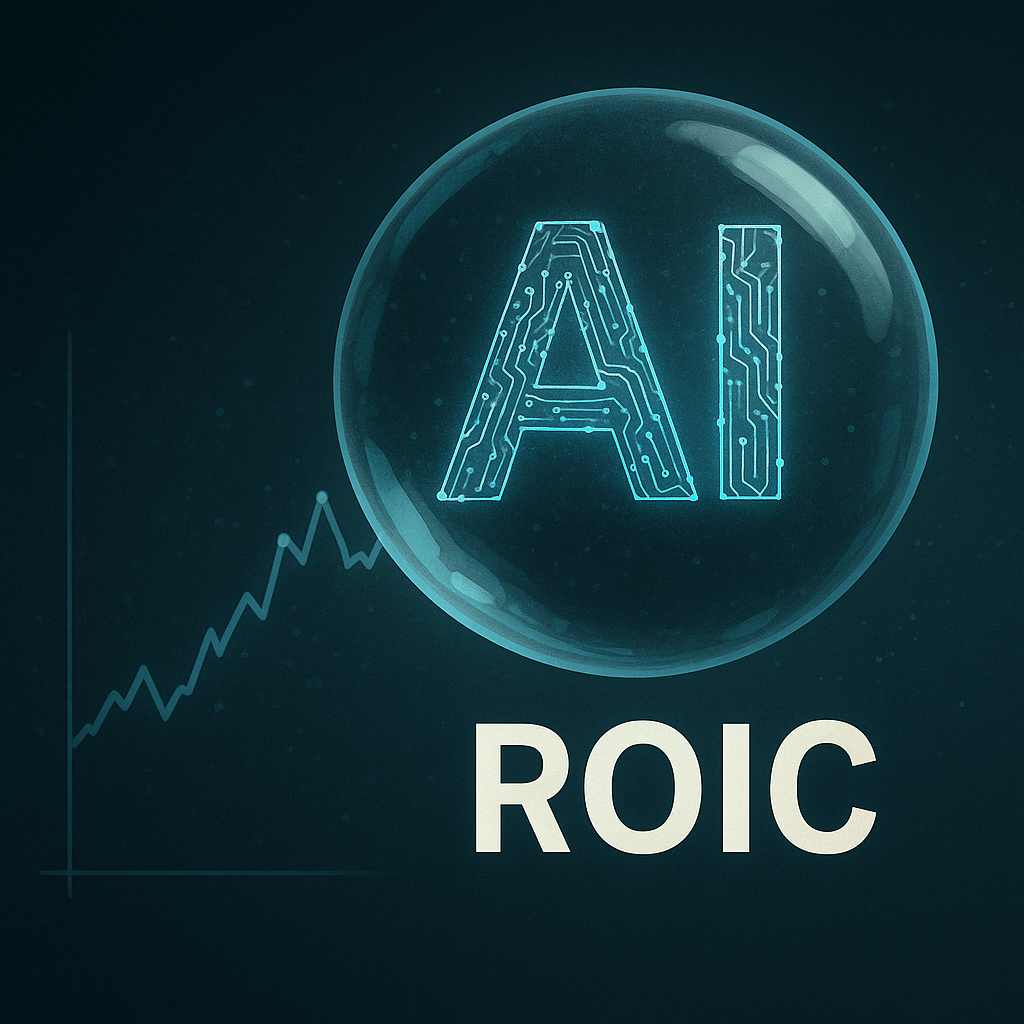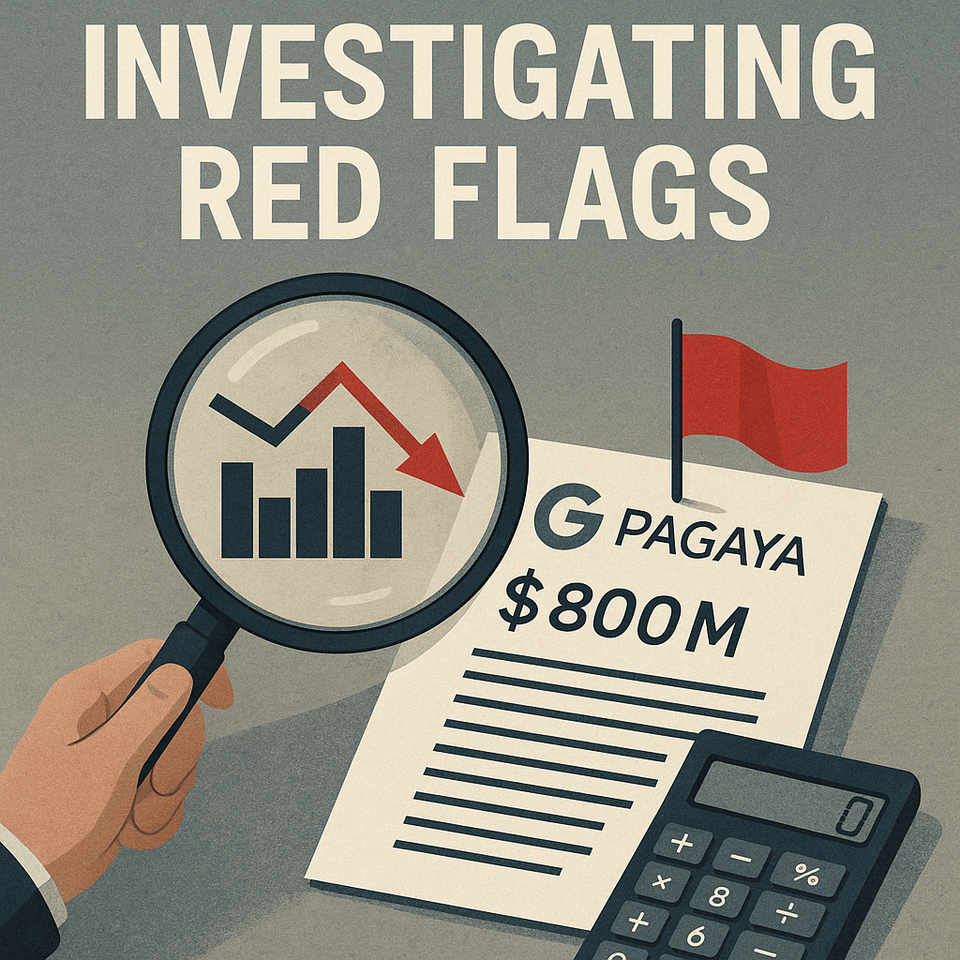Beyond Operating Assets: Redefining ROIC for Tech Investors

Summary
- This project builds a capital‑allocator ROIC that judges how software CEOs deploy every dollar of capital, departing sharply from the traditional “operating‑asset” metric.
- We expand invested capital to include goodwill, unrecognised SBC, cash + investments, purchase commitments, and non‑current deferred revenue, items that better reflect how software firms fund M&A and talent.
- Current NWC still nets against IC, but long‑term customer prepayments, ROU assets (minus lease liabilities), and capitalised commissions are also adjusted so ROIC rewards the free financing typical in SaaS models.
- The tailored formula has been run on PANW, FTNT, META, PLTR, and AVGO, producing very different ROIC profiles than the standard approach.
- This ROIC framework will continue to be refined; we plan to refine it continuously, and subscribers are invited to suggest improvements or edge‑cases we should test next.
Why is ROIC Important?
ROIC is a single, powerful metric that captures both growth and economic profitability in one number:
- ROIC = NOPAT (t-0) / Invested Capital (t-1)
Looking at growth alone is meaningless because investors ultimately seek profitability. Likewise, profitability without growth is insufficient because, over time, a stagnant company risks losing market share and will likely see its profitability erode as it is forced to discount pricing or increase S&M and R&D spending.
Even blended metrics like the Rule of 40 fall short, as they do not reflect how efficiently capital has been allocated and deployed. ROIC answers this gap. In essence, ROIC can be thought of as a Rule of 40 measured against the capital deployed by management — capturing both operational performance and how effectively investor capital is being utilized.
Defining Invested Capital
The key challenge in calculating ROIC — especially for software companies — is correctly defining invested capital, the denominator. There are two common methods:
1. Asset-Side (Operating Asset Approach)
Invested Capital = Total Operating Assets − Non‑Interest‑Bearing Current Liabilities (NIBCLs)
The logic here is simple: capture all the assets used to generate revenue, subtract the “free” funding from suppliers (accounts payable, deferred revenue, etc.). However, this method is less appropriate for software companies. It assumes operating assets capture all value-generating assets, but for software firms in particular, operating assets are only a small part of the capital truly driving output.
2. Sources-of-Capital Approach (Equity + Debt − Non-Operating Assets)
Invested Capital = Equity + Interest‑Bearing Debt − Non‑Operating Assets (excess cash, investments, goodwill, idle real estate, etc.)
This method starts with the capital provided by shareholders and lenders and strips out idle or non-productive assets. The flaw here is it assumes all money received by capital providers is deployed into operating assets like PP&E or working capital, whereas in software businesses, much of the capital funds intangibles like talent, stock-based incentives, and acquisitions.
Choosing between the asset-based and financing-based approaches to ROIC ultimately depends on what you want to measure. The asset approach emphasizes how effectively a company’s tangible and intangible operating assets generate returns, while the financing (sources of capital) view shifts the focus to how well management allocates capital — regardless of where that capital is deployed. We prefer the latter, as it places greater accountability on management for all capital allocation decisions, not just those tied to traditional operating assets. This perspective underpins the methodology throughout the rest of this report.
It’s also worth noting that the ROIC framework we’re building here differs from how we typically approach DCF valuations. In a DCF, we first estimate enterprise value (EV) and then reconcile that to equity value. Since EV excludes non-operating assets, the DCF is inherently aligned with the asset-based view of ROIC. In contrast, the ROIC we’re developing here takes a financing-based, capital allocator perspective. But because we’re not using this ROIC directly in the valuation model, there’s no inconsistency in applying a different approach.
What's Right with Traditional ROIC?
Certain elements of traditional ROIC already work well for software companies. Below we list out the components of invested capital that are naturally incorporated in the two versions of ROIC shown above:
Net Intangible Assets and Net PP&E
These are already fully captured. For example, when a company capitalizes $1 of intangible assets, that amount is immediately added to invested capital, increasing the denominator. Amortisation of the intangible asset occurs via the P&L, reducing NOPAT over time. Then this amortization expense comes off the intangible asset on the balance sheet, presenting a net value. This mirrors how depreciation works for tangible assets, or PP&E, and avoids double-counting. Each dollar affects ROIC only once — through the numerator via amortization and subsequently that $1 is then taken off the value of the asset in the denominator.
Net Working Capital (NWC)
As per the standard method, we define NWC as Operating Current Assets minus Non-Interest-Bearing Current Liabilities (NIBCLs). For software companies, operating assets typically include accounts receivable, prepaid expenses, and capitalized commissions — all directly tied to future revenue. NIBCLs include deferred revenue, accounts payable, and accrued liabilities — short-term obligations that don’t require interest payments and effectively provide free working capital.
In license-based software models, multi-year deals with large upfront payments produce significant deferred revenue, resulting in deeply negative NWC. While SaaS initially compressed deal lengths to one-year subscriptions — especially in seat-based models — many high-performing SaaS firms have found ways to reintroduce this working capital leverage. This can happen through multi-year prepayments incentivized via discounts, or in consumption-based SaaS where customers top up based on forward-looking usage estimates spanning multiple years.
This negative NWC is not a flaw — it’s a powerful source of capital efficiency. It allows companies to fund operations using customer cash, reducing the need for external capital. In our ROIC framework, these NIBCLs reduce invested capital and thereby mechanically increase ROIC. This is exactly the kind of commercial leverage and capital-light growth we want ROIC to reward. Reversing the treatment in some way and treating negative NWC as invested capital would penalize software firms for their efficiency and distort the purpose of the metric.
Deferred Contract Costs
We include deferred contract costs in invested capital because they represent a real, upfront economic outlay made by the company to secure future revenue. These typically consist of capitalized sales commissions that are paid to sales staff when a long-term contract is signed. Rather than being expensed immediately, they are capitalized and amortized over the life of the contract to match the revenue recognition pattern. Economically, these costs are equivalent to acquiring an asset — a future income stream — and are necessary for generating the contracted revenue. Since they are directly tied to core operations and recognized as operating assets under US GAAP (ASC 340-40), they should be included in invested capital to reflect the true capital deployed in the business.
Note 1: If the company doesn't show Deferred Contract Costs separately on the balance sheet, they may be bundled with either Prepaid & Other Current Assets or Other (Non-Current) Assets. Either way, as per the traditional ROIC formulas, deferred contract costs are already incorporated into invested capital and no adjustments are required.
Note 2: because sales commissions are already capitalised in Deferred Contract Costs, any broader attempt to capitalise additional S&M spend must avoid double‑counting; analysts would need to isolate marketing and other discretionary S&M items separately, then decide whether and how to amortise only those incremental portions. As we discuss later on, given the lack of disclosure granularity in the 10K and 10Q, this would be nigh on impossible to do with a high confidence level anyway.
What's Wrong with Traditional ROIC?
Traditional ROIC is rooted in industrial business models, focused on returns generated from physical operating assets. However, for software businesses, or for investors/analysts wanting to focus on the ability of management to allocate all capital, it doesn't fit well for several reasons:
Equity and debt capital fund more than operating assets
They also fund acquisitions (goodwill), stock-based compensation, and other assets not strictly considered "operational", each of which are critical in software but excluded from traditionally defined invested capital.
No Accounting for Stock-Based Compensation
We're including stock-based compensation (SBC) in invested capital because it reflects a real and recurring economic commitment to attract and retain the talent that drives software companies. While SBC doesn’t involve an upfront cash outlay like acquiring PP&E or making acquisitions, it is still made possible by capital providers — who accept dilution in exchange for long-term value creation. Unlike goodwill, which results from explicitly deploying capital to acquire external assets at a premium, SBC is a form of internal investment: equity is granted to employees in exchange for future work that supports revenue generation.
Our preferred method is to use the unrecognized SBC balance disclosed in the footnotes (usually one of the latter sections after Commitments & Contingencies), which represents the remaining amortization of outstanding RSUs and options and functions as a long-term labor-related asset. If unavailable, we estimate it using 4× TTM SBC (of the previous 12 months, not the latest 12 months), based on the typical four-year vesting schedule. Either way, we leave GAAP SBC expense in NOPAT, as it amortizes this capitalized asset over time. There’s no need to model the roll-forward unless projecting ROIC beyond 12 months.
Goodwill Exclusion Is Misleading
Goodwill is categorized as a non-operating asset and hence is excluded from the traditional ROIC formulas. However, if you prefer to take a capital-allocator view on ROIC, it should be included in invested capital and ROIC. Goodwill represents premiums paid in M&A — capital deployed by management, rightly of concern to investors. Excluding it from invested capital ignores management's historical capital allocation. However, goodwill exclusion could make sense if evaluating a business post-acquisition where management will change, in which case you might only include goodwill generated going forward.
Including goodwill can have big implications in comparative analysis. For instance, a key factor in PANW's much lower ROIC - based on our tailored version - than FTNT's is PANW's $3bn+ of goodwill versus FTNT's ~$100m. You can click the links to see the tailored ROIC of PANW and FTNT, along with META and PLTR later in the report.
Cash, Equivalents, and Investments
Traditionally, excess cash, cash equivalents, and marketable investments (both short- and long-term) are excluded from invested capital because they are not tied to core operating activities and are also excluded from enterprise value (EV), with which ROIC is normally aligned. However, in our capital-allocator-focused ROIC framework, we take a different view. Whether management chooses to hold large cash reserves, invest in short-term instruments, or deploy capital into other companies’ equity or debt, these are capital allocation decisions made using equity and debt capital provided by investors. Including these items in invested capital aligns with our rationale for including goodwill — both represent real decisions by management about how to deploy capital and should be assessed for effectiveness.
Moreover, including these balances helps avoid distortions that often arise in software companies with structurally negative net working capital, where deferred revenue far outweighs operating current assets. In such cases, excluding cash and investments can lead to artificially low or even negative invested capital, making ROIC incalculable. Including these balances helps ground the denominator and ensures ROIC better reflects the full picture of capital deployment.
One implication of this approach is that it may cause ROIC to vary more meaningfully depending on a company’s capital return posture. For instance, companies that run aggressive buyback or dividend programs — such as Google — will appear to have higher ROIC because their cash balances are lower, reducing the denominator. Conversely, newly public or fast-growing software firms that have recently raised capital and are yet to deploy those funds may show lower ROIC figures, not because of inefficient operations, but because large cash reserves inflate invested capital in the short term. While this may appear to penalize growth companies, it reflects our framework’s intent: to assess how effectively capital — regardless of timing — is allocated and deployed over time.
DTAs Are Mishandled
Deferred Tax Assets (DTAs) arise from tax timing differences, not from deploying capital, and therefore shouldn’t be included in invested capital. Instead, compute NOPAT using cash taxes (not accrual tax expense) to reflect true economic cost. Alternatively, adjust reported NOPAT by adding the increase (or subtracting the decrease) in net DTA — since an increasing DTA implies reported tax expense overstates actual cash taxes paid. By doing this, we handle Net DTAs on the numerator side only, and exclude it from the denominator side, thus avoiding any double counting.
Other Assets
Although more debatable, we've decided to include “Other Assets” in invested capital because they often contain line items with operating relevance that are not individually disclosed but are nonetheless essential to ongoing business activities. While these accounts can sometimes include non-operating items like deferred tax assets (DTAs), most companies break DTAs out separately on the balance sheet, allowing for selective exclusion where appropriate. The remaining components of Other Assets frequently relate to operational prepayments, long-term receivables, or vendor relationships, all of which support revenue generation or service delivery. Sometimes deferred contract costs are not shown separately and are included in Other Assets. Given that our approach builds invested capital from the bottom up — explicitly including all economically productive assets — we believe it is more consistent and conservative to include Other Assets in invested capital, unless a clear non-operating component can be identified and stripped out.
Operating Leases (ASC 842 & IFRS 16)
Under ASC 842, operating leases give rise to two components: a Right-of-Use (ROU) asset and a lease liability. The ROU asset represents a productive resource — such as office space or infrastructure — that the company uses to generate revenue, and should be included in invested capital. The lease liability, however, should be excluded due to the way lease costs are accounted for in the income statement.
The lease expense reported under ASC 842 is a single straight-line figure that blends both the interest and principal components of the lease payments. The principal portion economically resembles depreciation: it flows through the income statement as part of the lease expense and reduces the ROU asset over time. As such, it is already captured once — through NOPAT — and reduces the capital base by lowering the book value of the ROU asset each period. This avoids any double counting.
The interest portion, however, accrues separately on the lease liability and increases its carrying value until paid. Since this interest cost is also embedded in the lease expense that reduces NOPAT, including the lease liability in invested capital would double-count the financing cost — once in the numerator via lower NOPAT, and again in the denominator through interest accruing and increasing the value of the lease liability.
Therefore, to preserve internal consistency and avoid distortion, we include the ROU asset (which behaves like PP&E) and exclude the lease liability under ASC 842.
Under IFRS 16 - or under ASC 842 if a US GAAP company has finance leases rather than operating leases - lease payments are separated into depreciation (above EBIT) and lease interest (below EBIT). If you exclude the lease liability under IFRS 16 — as we recommend — you must add back lease interest to NOPAT to avoid overstating the return. The treatment of the ROU asset remains unchanged: it reflects the use of a productive asset and should be included in invested capital.
Summary on Operating Leases:
- ASC 842:
- Include the ROU asset.
- Exclude the lease liability.
- No adjustment needed to NOPAT, as principal is embedded in lease expense and reduces the ROU.
- IFRS 16 or Finance Lease under ASC 842:
- Include the ROU asset.
- Exclude the lease liability.
- Add back lease interest to NOPAT to avoid overstating returns.
Purchase Commitments Are Ignored
Purchase commitments represent future cash outflows already contractually locked in — economically similar to debt or leases. Including them in invested capital provides a more accurate picture of resources committed to future operations. While companies only disclose undiscounted totals, a quick, scalable method is to apply a 20-25% haircut — reflecting typical 3-5 year commitments and an 8-12% WACC. Where disclosures break commitments into buckets (<3 years, 3-5 years, >5 years), apply tiered discounts of 15%, 25%, and 35%. This captures the obligation economically without detailed present-value modeling, keeping ROIC scalable across larger cohorts.
It's worth noting that this approach may penalize companies like Palantir (PLTR) that pursue long-term infrastructure agreements to lock in better pricing and support anticipated scale. These large, multi-year purchase commitments raise invested capital today, while the economic benefits — higher revenue and profitability — often don’t materialize until several years later. As a result, near-term ROIC may be temporarily suppressed despite disciplined, forward-looking capital allocation. Conversely, companies that avoid such large commitments (like Monday) may appear more capital efficient in the short term, but they could face higher infrastructure costs in the future if they’re unable to secure similarly favorable terms, which may ultimately compress margins and depress NOPAT. This trade-off highlights the challenge of timing in ROIC analysis when evaluating long-duration investments.
Note: COVID‑era shortages pushed many hardware‑centric tech companies to lock in multi‑year supply deals, sharply lifting purchase commitments. Apple is a prime example: its FY22 10‑K shows non‑cancelable component obligations of roughly $120bn, up from about $54bn pre‑COVID, as it prepaid to secure chip and display capacity. Similar step‑ups appear at Nvidia and AMD, which each disclosed multibillion‑dollar wafer‑supply contracts with TSMC. Under our methodology, these long‑term commitments inflate invested capital today and can temporarily dampen ROIC, even though they hedge input costs and protect future margins.
Deducting Non-Current Deferred Revenue
In both traditional ROIC formulas:
- Invested Capital = Total Operating Assets - NIBCLs
- Invested Capital = Equity + Debt - Non-Operating Assets
only the current portion of deferred revenue is automatically deducted (through NIBCLs). The non‑current portion is left inside the capital base even though it represents cash customers have advanced for services that will be delivered later — cash the company did not have to raise from shareholders or lenders. Large non-current deferred revenue amounts are common for software companies.
Because our ROIC is capital‑allocator focused, we want the denominator to capture only the capital that management has actually committed, not the interest‑free financing it has received from customers. We therefore make one extra adjustment: subtract non‑current deferred revenue from invested capital, just as we already do with the current portion. This keeps the metric aligned with our guiding principle — holding management accountable for the capital they deploy — while ensuring companies that lock in multi‑year customer prepayments are rewarded, not penalised, for that source of zero‑cost funding.
Should R&D and S&M be Capitalized???
In theory, the “purest” ROIC would capitalise any portion of R&D or S&M that produces benefits extending beyond one year, because those outlays are economically no different from building a factory or buying a licence: they create assets that yield future cash flow. In practice, however, R&D and S&M lines are mosaics. R&D bundles salaries, SBC, cloud compute, prototype gear, rent on lab space, depreciation of test rigs, and patent‑filing costs — some clearly operating expenses, others arguably long‑lived. Even management rarely knows what share will prove durable; a patent may be abandoned, a prototype scrapped, and engineers may split time across COGS, G&A, or customer support. S&M is equally mixed: commissions for multi‑year deals are capitalised as deferred contract costs, but the rest — campaign spend, partner enablement, brand work — may or may not pay off beyond 12 months. An analyst could guess an average capitalisable percentage for a peer set and amortise it, but the estimation error would vary wildly company by company and would require removing that slice from the P&L, creating a balance‑sheet asset, and maintaining an amortisation roll‑forward — adding complexity without guaranteed accuracy. These grey areas are exactly why accounting standards keep R&D and most S&M fully expensed: the line between “future asset” and “period cost” is too blurry to codify consistently. Therefore, due to the uncertainty and complexity, we will not make adjustments for R&D and S&M - though if we're feeling super ambitious, we may explore further at some point in the future.
Summary of Specific Adjustments for a Capital-Allocator, Software-Tailored ROIC
- Net Property, Plant & Equipment (PP&E)
- Include as usual: these are productive assets used in operations.
- Right-of-Use (ROU) Assets for Leases
- Include ROU assets in invested capital.
- Exclude lease liabilities.
- Under ASC 842: no income statement adjustments needed.
- Under IFRS 16 (or Finance Lease under ASC 842): add back lease interest to NOPAT.
- Intangible Assets (Net of Amortisation)
- Include acquired intangibles and capitalised software development costs.
- No special adjustment needed — standard GAAP amortisation flows through NOPAT and then the deduction is reflected in Net Intangibles.
- Goodwill
- Include if your goal is to assess historical capital allocation.
- Exclude if a new management team has taken over and where prior management’s decisions are no longer relevant.
- Cash, Equivalents & Investments (Short and Long-Term)
- Traditionally excluded from ROIC, but we include them to reflect capital allocation decisions made by management.
- Helps avoid distorted or negative invested capital in software firms with large deferred revenue and negative NWC.
- Inclusion is consistent with our rationale for including goodwill — both reflect management's deployment of capital.
- Other Assets
- Include as part of invested capital if they are primarily operating in nature (e.g., security deposits, prepaid infra).
- DTAs are sometimes grouped here but usually disclosed separately.
- Including Other Assets ensures we capture all productive or revenue-enabling assets not explicitly listed elsewhere.
- For the sake of scaling the application of this ROIC, it makes more sense to simply include Other Assets rather than attempt to find out precisely what it includes, which may not be possible anyway.
- Deferred Tax Assets (DTAs)
- Preferably exclude from invested capital.
- Adjust NOPAT by using cash taxes (or reflect changes in DTAs) to avoid distortion.
- Capitalised Stock-Based Compensation (SBC)
- Find the unrecognised SBC balance in footnotes (or use 4× TTM SBC as a proxy).
- Add this to invested capital to capture the “asset” being amortised through NOPAT.
- Do not adjust NOPAT — GAAP SBC expense already amortises this asset.
- Purchase Commitments
- Purchase commitments are future cash outflows supporting operations, similar to leases or debt.
- Discount the total commitment by 20-25% as a practical shortcut (reflecting 3-5 year durations at an 8-12% WACC).
- If companies disclose tenure splits, apply: 15% (<3 yrs), 25% (3-5 yrs), 35% (>5 yrs).
- This approach avoids building detailed PV models while maintaining reasonable accuracy.
- Net Working Capital (Operating)
- Include A/R, prepaid expenses, inventory (if any).
- Subtract NIBCLs: A/P, accrued expenses, deferred revenue.
- Exclude cash and equivalents.
- Simplest method: use current assets minus NIBCLs.
- Non-Current Deferred Revenue
- Deduct from invested capital as it is a source of free financing from customers.
- Current deferred revenue is deducted as part of factoring in NWC into invested capital, so this adjustment to the non-current portion is necessary and rewards the company with a higher ROIC.
Final Word
This work redefines ROIC through the lens of capital allocation — tailored specifically for software companies where value creation stems not from physical assets, but from strategic M&A and talent acquisition funded through SBC. Traditional ROIC formulas fall short in capturing these dynamics. By recalibrating invested capital to include goodwill, unrecognized SBC, and purchase commitments, and deducting non-current deferred revenue, we better align the metric with how management truly deploys capital. The result is a capital-allocator focused ROIC that holds software leadership teams accountable for the decisions that matter most to shareholders.
Applying the Capital-Allocator Software Tailored ROIC
Here is the template for this customized ROIC calculator:
https://poe.com/preview/6ladPFeXlH3LoU8DF9qB
Feel free to input the figures for another stock. Below we have applied the calculator to a few stocks under our coverage.
Palo Alto Networks
https://poe.com/preview/9Mcy8vir189mkoiYHaO6
Fortinet
https://poe.com/preview/eRGoia7NSvLjiRuPCBeE
Meta Platforms
https://poe.com/preview/9X2EoFaOUj83mBaqfZw2
Palantir
https://poe.com/preview/eiB5PdjbQlvP1wnmRg5B
Broadcom
https://poe.com/preview/ZLMwFiC6gfEbfOcwg35j
If you are interested in helping refine this tailored ROIC, please get in touch.




